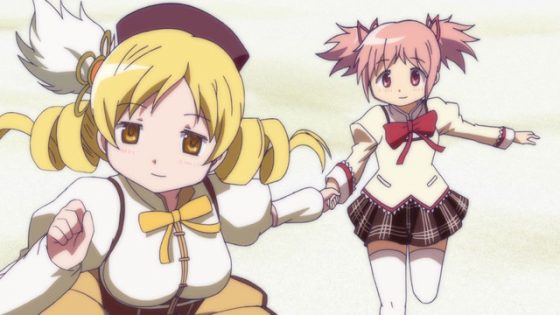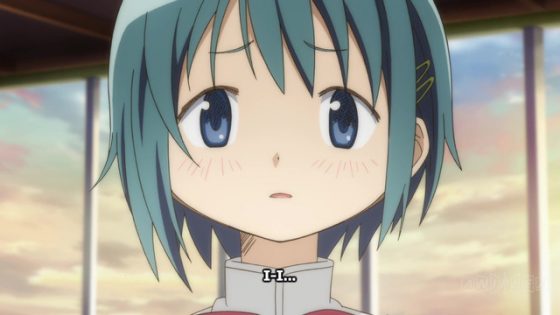
Madoka Magica takes cues from its mentors, learning from their lessons and ideas. By borrowing themes from magical girl stories and twisting them for an older audience, Madoka Magica denies its characters a childhood.
This loss of childhood parallels our own experiences, a one-way journey towards growing up--adulthood gained through loss. In this article, we will discuss how literature handles the subject of innocence and contextualize it within the show. By doing so, I hope to analyze the duality of hope as shown through objects.
Context: the Fall from Innocence
In literature, there are several famous falls. In the Bible, the “Fall of Man” describes mankind’s transition from a state of innocence/purity to one of knowledge/impurity. This occurs when the Devil, in the form of a serpent, tempts Adam and Eve to eat from the Tree of the Knowledge of Good and Evil.
Adolescence, the transition from child to adult, is described similarly. This fall is a part of our growth, an event we had or will experience. We fall from a state of bliss and ignorance (childhood) in order to enter adulthood.
The Catcher in the Rye by J.D. Salinger is a popular English book taught in middle/high school. In this story, the protagonist likens adolescence to children playing in a rye field. If they venture too far, they can fall off a dangerous cliff. To prevent that, he wishes he could catch those who “fall from innocence.”
To become an adult, however, one must take on more responsibilities. This leads us to make decisions we might regret. This is our rite of passage, our ticket to adulthood. To gain knowledge, one must be allowed to make mistakes. To move through life is to stumble forward, falling gently one mistake at a time.
Madoka’s mom, Junko Kaname, is a perfect example. Throughout the show, she is often drinking. She stumbles forward into scenes just as she does through life. During episode 6, Madoka wakes up at night and sees her mother drinking. Lost on how to help her friend Sayaka, Madoka asks for advice.
Her mom responds, “Sometimes you tell an awful lie, or run away from something scary… and then later look back… and realize that was actually precisely the right thing to do, right? If you can see there’s no way for your friend’s problem to end but in disaster… it’d be better for her to crash and burn sooner rather than later.”
Junko provides insight. Despite Mami’s death, Madoka still has a role model and guardian. Junko speaks from experience, highlighting the importance of making mistakes. Junko speaks further, contextualizing her advice for Madoka:
“You always try your best to do the right thing… Which is why it may be good for you… before you become an adult to learn how to mess up… When you grow up, you see, the consequences for messing up get bigger and bigger. The more responsibilities you start shouldering, the more important it gets to not make the wrong move.”
The series starts out protecting its characters. However, when their lives suddenly shift, their descent into adulthood is ill-timed. While other characters suffer tragically for this, Madoka is fortunate. She is constantly warned about becoming a magical girl too soon.
Her wish to be a magical girl--her rite of passage--must be done later when “the time is right.” She must fall gently so that her innocence survives her fall. So she can live in an adult world without losing herself in it.
Absence of a Protector: Venturing Outwards
After Mami dies, the “world has changed,” and while there were hints before, now it comes as coldly and abruptly as her death. There is little time to adjust. The cast is ushered into a new world, one that shuns their naiveté and punishes their mistakes.
It is ambivalent and cold-hearted. It is confusing and without clear directions. Without guardians--a decision the show emphasizes by not showing parents other than Madoka’s--the kindness these girls once knew seems like a lie.
The city’s true colors are revealed. Ten minutes into episode 4, Madoka and Homura walk across a bridge. The evening sun casts their shadows onto the street. A traffic line cuts through each shadow’s neck, a reminder of how Mami dies.
To the right of them is the shadow of the city. Covered in darkness, industrial buildings hover over the characters, mocking them for their blindness: this ugly side of the city always existed. Lighting and architecture no longer shield the characters--they are grim reminders; they’ve stepped outside the garden.
This is why the show pays such close attention to light and architecture, they are an integral element to the show, a reflection of the characters. Even mundane objects have implications.
At the beginning of episode 4, Sayaka rushes to meet her crush, Kyousuke Kamijo. The same red hue in Madoka and Homura’s bridge scene is here, its melancholy mood felt instantly. When Sayaka opens the door to his hospital room, all that remains are an empty bed and chairs.
In art, an empty chair has several meanings. For now, we’ll discuss briefly two. A chair is a recognizable object, one we use day-to-day. It implies a person’s presence and with that hope: a return of that person or a return to the familiar.
An empty chair can also mean the exact opposite--a duality that fits this show very well; hope prolonged invites despair. Empty chairs can mean something irreplaceable, lost forever. Thus, what matters is tone--of which the lighting provides easily in scenes.
This duality of “presence and absence” appears several times in Madoka. In episode 11, Kyubey enters Madoka’s room. Contextually, this is after Sayaka’s funeral and after her “soul” has died--not peacefully, but in a way that subverts her significance, her very wish.
She curses her ignorance--her ridiculous belief that justice ever existed. Her soul gem darkens, turning her into a witch. She dies believing she meant nothing. Her wish to help someone meant absolutely nothing.
With that context, when Kyubey explains that magical girls are an energy source for the universe, he does so with a visual example: livestock. According to Kyubey, human suffering is seen as nourishment.
If suffering exists only to keep a cold, uncaring system running, human suffering and by extension human significance means nothing. In this world, there is no net positive or net negative. For an equal amount of happiness, there must be an equal amount of suffering. This doesn’t account for the individual or their personal experience.
Hope can provide happiness--your wish for someone to return, for their presence to be felt, for that person to exist once more. It can also be a cruel reminder. When Madoka looks around her room, there are only empty chairs. No Mami, no Sayaka, no Kyouko, no one to care for their suffering. There is no hope.
Nothing.
Final Thoughts

Puella Magi Madoka Magica is a reaffirmation of magical girl stories. By applying its themes towards a wider audience, it gives insight on their importance--the reason why these stories should exist for children. By contextualizing it for an older audience, it reminds us of ourselves and how we’ve all stumbled in our journey towards adulthood and the necessity for hope.
For the next article, I will talk about the importance of mentors in the magical girl genre and how Madoka Magica paves its uncertainty with this expectation.

